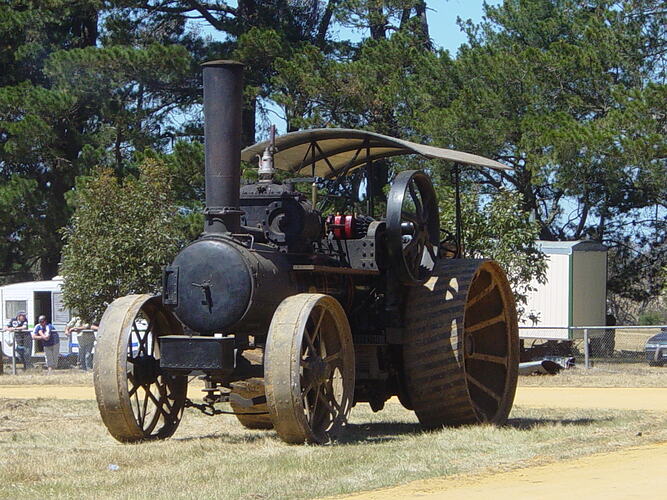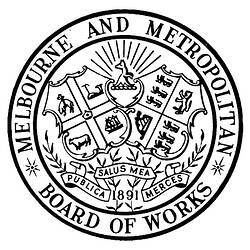Summary
Class Z7 25 nominal horsepower (225 indicated horsepower) 8-inch (203.2 mm) & 14-inch (355.6 mm) bore x 14-inch (355.6 mm) stroke double-crank-compound cable ploughing engine, serial no.15505, built by John Fowler & Co. Ltd., Leeds, in 1919. The ploughing engine is fully restored and in operating condition.
This engine was one of a pair of Fowler Z7 ploughing engines purchased second hand by the MMBW in 1927 from the Murrimbidgee Irrigation Authority. The other engine was serial no. 15506. The engines were used at Werribee Farm for ploughing, sludge clearing and powering saw milling equipment until the early 1950s when 15506 was cut up and 15505 was displayed in a park at the Werribee Farm. No. 15505 was restored in 1983-84 by Bob Butrims and Bruce Roberts with assistance from MMBW employees at Werribee.
This engine is currently on loan to the Lake Goldsmith Steam Preservation Association and regularly appears operating under steam during the Lake Goldsmith Steam Rallies held in May and November each year.
Significance
Steam ploughing engines were first used in Australian around 1860, less than a decade after the technology had been developed in England. Australia remained one of the most important export markets for British ploughing engines, particularly for the products of John Fowler & Co., who dominated the market from the 1880s till the end of steam power in the 1930s. The Z7 class engines, of which this is an example, were the largest ploughing engines built by Fowlers and one of the largest mobile steam engines ever produced in quantity. Though rated at 25 nominal horsepower, the huge 25 tonne machine could produce a peak power of up to 250 indicated horsepower (187 kW), with typically 200 brake horsepower (150 kW) available on the flywheel or cable drum. Interestingly, this is roughly equivalent to the output of one of the triple-expansion engines in the Pumping Station. Despite its prodigious power output, the compound steam cylinders and 180 psi (1,240 kPa) boiler pressure provided excellent fuel economy.
Though they were expensive to purchase and operate, cable ploughing engines played an important role in the development of early Victoria agriculture. They were used not only for cultivation, but also for land clearing and preparation, stump-pulling, drainage works, dam & irrigation channel digging, dam cleaning and general construction work, as well as for driving a range of stationary machinery such as rock-crushers, sawmilling equipment and agricultural machinery.
With the construction of the Melbourne Sewerage System in the 1890s, a treatment works was established by the Melbourne & Metropolitan Board of Works on 3,500 acres of land at Werribee. Raw sewage collected throughout the city drained through a network of unground sewers to Spotswood Pumping Station, where it was raised from 21 metres underground by steam (and later electric) pumps and feed it through pipes to a surface outfall drain running from Brooklyn to Werribee. At the farm the raw sewage was treated naturally by flood irrigating pasture for grazing. Cleansed effluent was collected from the subsoil layer by drainage channels and discharged directly into Port Phillip Bay.
During the early decades of the sewerage farm's operations, sewage was treated primarily by a system of land filtration. This required extensive preparation of the land by first subdividing the paddocks into evenly graded bays, digging distribution and drainage channels and then breaking up the soil and subsoil to assist the filtration process. To undertake this task the Board initially purchased two second-hand 14n.h.p. compound Fowler ploughing engines (serial nos.4387 & 4388, of 1882) from East Loddon Station near Surpentine in central Victoria. The engines came with a range of standard implements including a large single-furrow Oliver balance plough, a five-furrow balance plough, light and heavy cultivators, a mole drainer and a "Crosskill" roller. All implements were specially designed to work backwards and forwards in two directions being pulled by the cables from the two ploughing engines. Both of these initial engines were retired and broken up for scrap just before the Second World War.
As Melbourne's population grew after the First World War, the farm had to be expanded with additional ground being prepared for land filtration. To assist in this task the Board of Works sought additional steam ploughing engines during the 1920s and after a search and protracted negotiations, this engine (serial no.15505) and its matching pair (serial no.15506) were purchased from the New South Wales Government, together with a five-tyne knifer, for £2,500. The two engines were part of three Fowler ploughing engine sets imported by New South Wales in the early 1920s for use on the Murrumbidgee Irrigation System, where they were employed in land-clearing, channel digging and land preparation for orchards and cropping. Mr J.F. Key, Chief Engineer of the Spotswood Pumping Station was sent up to Griffith to inspect the engines and arrange for their transport to Werribee.
The additional engines arrived at Werribee in January 1927, and over the next two decades were to provide the principal source of motive power on the farm. One of the main tasks on which they were employed was in preparing new ground for land filtration. This involved using the giant Oliver plough to rip through the topsoil and subsoil to a depth of 2 ft 6 in. (0.76 m), a task which required all of the engines' horsepower. Apart from this, the engines were also used for scrapping out the sludge digestion and drying tanks, driving a sawmill and in land clearing work, using their large winch drums and 500 yard wire rope.
The ploughing engines were retired from active work in the early 1950s and no.15506 was broken up for scrap in about 1955. The single surviving engine was preserved on static display in a park at the old farm township. In the early 1980s, two steam enthusiasts Bob Butrims and Bruce Roberts approached the M.M.B.W. about purchasing the engine and ultimately arranged to restore the engine and operate it for the Board for occasional steam ploughing demonstrations at Werribee. All of the work was done voluntarily and the restorers had to provide a number of spare parts to complete the restoration.
The Fowler class Z7 compound cable ploughing engine, serial no. 15505, is of State Significance both because of the role it played in the development of the Melbourne Sewerage Scheme and as one of the best surviving examples of a technology that played a leading role in the development of early Victorian agriculture. Fowler ploughing engines like this one were widely used both by contractors and the government for cultivation, land-clearing, dam & channel-digging, irrigation works and a range of ancillary tasks. This particular steam ploughing engine has an association with the Spotswood Sewerage Pumping Station through its use at the Werribee Sewage Treatment Farm, between 1927 and the mid-1950s.
More Information
-
Collecting Areas
-
Acquisition Information
Donation from Melbourne Water, Western Treatment Plant, Melbourne Water, 16 Oct 2001
-
Manufacturer
John Fowler & Co. Ltd, Steam Plough & Locomotive Works, Leeds, Yorkshire, England, Great Britain, 1919
-
Past Owner
Murrimbidgee Irrigation Authority (MIA), Griffith, Riverina, New South Wales, Australia, 1920-1927
-
Past Owner
Werribee Treatment Works, Melbourne & Metropolitan Board of Works (MMBW), Sewage Treatment Farm, Werribee, Greater Melbourne, Victoria, Australia, 1927-1989
-
Past Owner
Western Treatment Plant, Melbourne Water, New Farm Road, Werribee, Greater Melbourne, Victoria, Australia, 1989-2001
-
Model Name or Number
-
Brand Names
-
Classification
-
Category
-
Discipline
-
Type of item
-
Overall Dimensions
7.595 m (Length), 3.11 m (Width), 4.56 m (Height), 24.4 tonnes (Weight)
-
References
Lake Goldsmith Steam Rally, [Link 1]
[Book] Butrims, Robert (Bob) & Roberts, Bruce. 1987. The Werribee Steam Ploughs. 60.
-
Keywords


